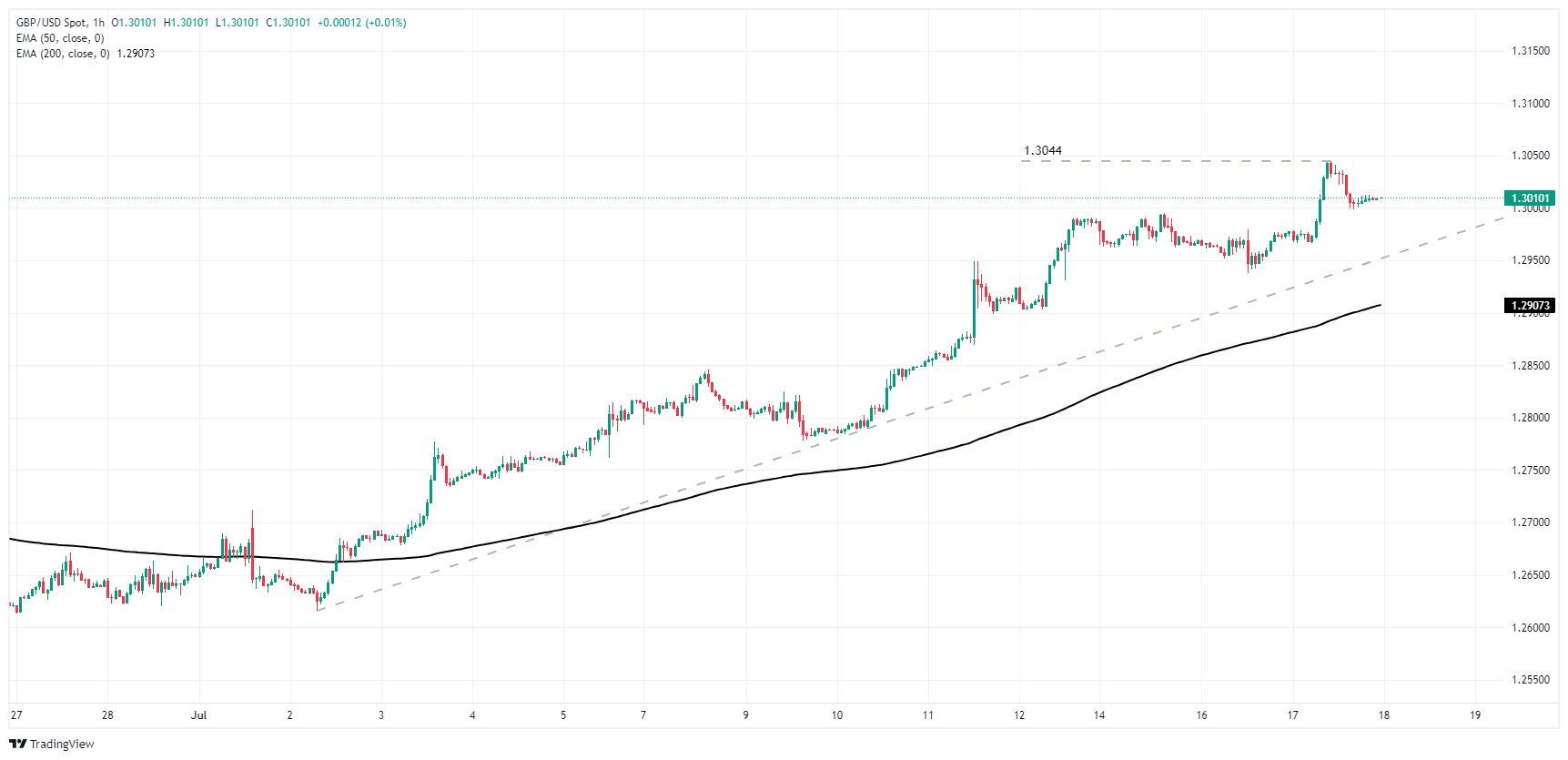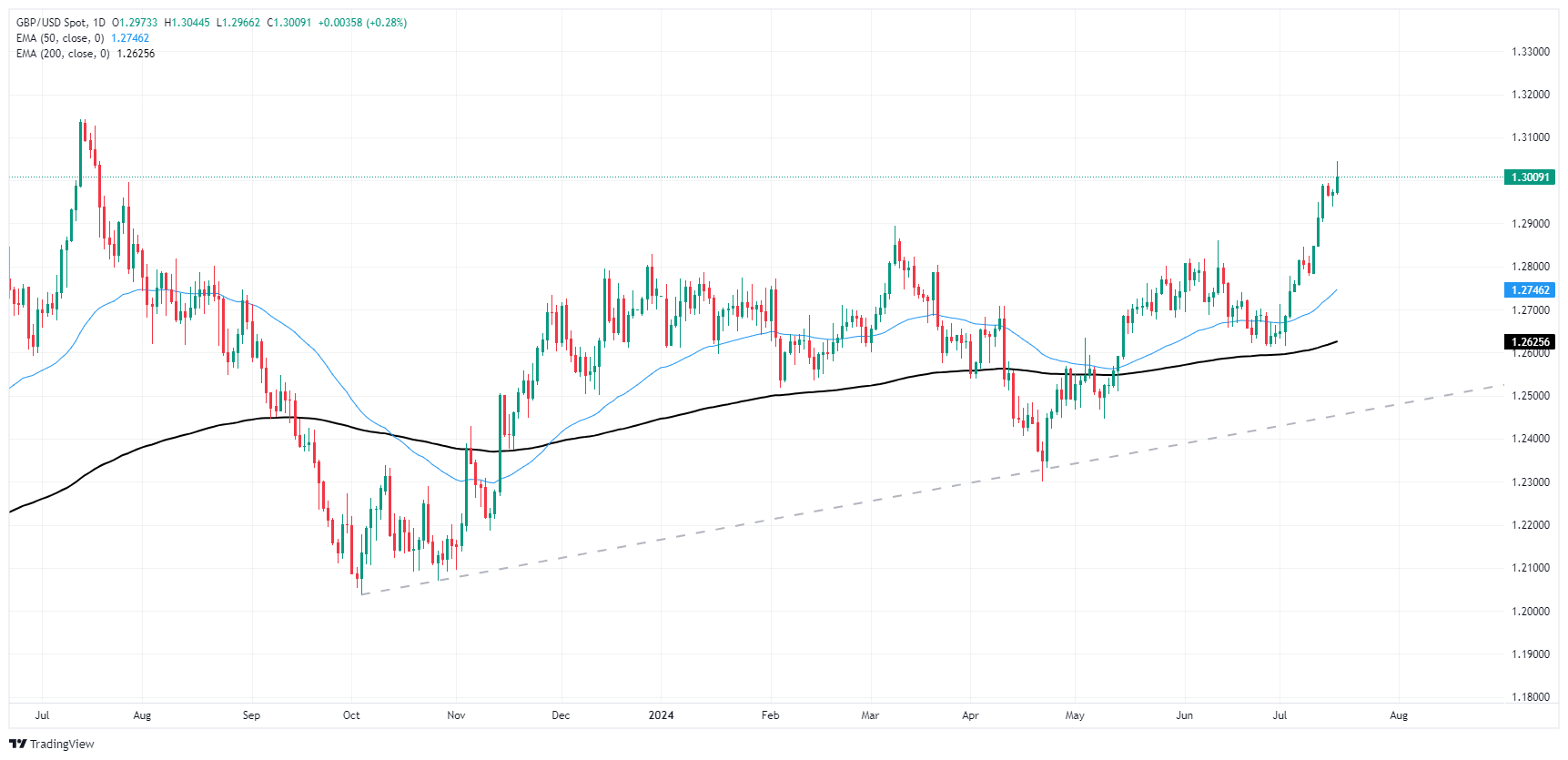- Аналітика
- Новини та інструменти
- Новини ринків
- GBP/USD reclaims 1.30 as markets tilt further into rate cut hopes
GBP/USD reclaims 1.30 as markets tilt further into rate cut hopes
- GBP/USD edged up a third of a percent on Wednesday.
- UK PPI inflation limited gains, but GBP traders look ahead to more UK data.
- Markets have fully priced in a September Fed rate cut.
GBP/USD inched further into fresh highs, testing chart territory north of the 1.3000 handle on Wednesday. Broad-market hopes of a rate cut from the Federal Reserve (Fed) in September kept the Greenback underbid and gave the Pound Sterling (GBP) a leg up in the mid-week market session. Recent Fedspeak has been interpreted as firmly dovish, with market participants seeing the writing on the wall they wish to as Fed officials give a head nod to recent progress on inflation measures. Cable traders will also want to keep an eye out for any knock-on volatility from the European Central Bank's (ECB) Thursday rate call.
Forex Today: The ECB and Lagarde steal the show
Rate markets have fully priced in at least a quarter-point rate trim when the Federal Open Market Committee (FOMC) gathers for a rate call on September 18, and July’s month-end meeting is still expected to keep rates flat. According to the CME’s FedWatch Tool, 98% odds of a September rate cut are fully priced in, with rate traders seeing three cuts in 2024 compared to the Fed’s own modest projections of one or two.
Final UK Consumer Price Index (CPI) inflation figures early Wednesday printed firmly within forecasts, giving GBP traders little to chew on, but a steeper-than-expected decline in UK Producer Price Index (PPI) inflation briefly weighed on the Pound Sterling. PPI producer-level inflation contracted by 0.3% MoM in June compared to the previous month’s revised 0.0% and entirely missing the forecast uptick to 0.1%.
Read more:
Fed's Barkin: Will debate at July meeting whether still appropriate to describe inflation as elevated
Fed's Waller: Most likely direction for monetary policy is rate cuts
Despite a broad-market dog-pile into Fed rate cut bets, Fedspeak from key policymakers maintains a dark tint to otherwise sunny skies. Both Fed Governor Christopher Waller and Richmond Fed President Thomas Barkin noted that labor markets remain particularly robust despite easing inflation pressures.
Thursday’s upcoming UK labor data dump will give GBP traders a firm directional tilt for the back half of the trading week. June’s Claimant Count Change is forecast to ease sharply to 23.4K MoM compared to the previous month’s 50.4K, while annualized quarterly Average Earnings Excluding Bonus is expected to tick down to 5.7% from the previous 6.0%.
Friday’s UK Retail Sales will round out the week’s UK data docket, and market model forecasts are calling for a -0.4% contraction in June’s retail spending volumes compared to the previous month’s wide surge of 2.9%.
British Pound PRICE Today
The table below shows the percentage change of British Pound (GBP) against listed major currencies today. British Pound was the strongest against the New Zealand Dollar.
| USD | EUR | GBP | JPY | CAD | AUD | NZD | CHF | |
|---|---|---|---|---|---|---|---|---|
| USD | -0.01% | -0.01% | -0.26% | -0.02% | -0.01% | 0.06% | -0.09% | |
| EUR | 0.00% | 0.01% | -0.26% | -0.01% | 0.02% | 0.07% | -0.08% | |
| GBP | 0.00% | -0.01% | -0.28% | -0.05% | 0.00% | 0.07% | -0.09% | |
| JPY | 0.26% | 0.26% | 0.28% | 0.25% | 0.27% | 0.25% | 0.20% | |
| CAD | 0.02% | 0.01% | 0.05% | -0.25% | 0.02% | 0.09% | -0.06% | |
| AUD | 0.01% | -0.02% | -0.01% | -0.27% | -0.02% | 0.06% | -0.07% | |
| NZD | -0.06% | -0.07% | -0.07% | -0.25% | -0.09% | -0.06% | -0.15% | |
| CHF | 0.09% | 0.08% | 0.09% | -0.20% | 0.06% | 0.07% | 0.15% |
The heat map shows percentage changes of major currencies against each other. The base currency is picked from the left column, while the quote currency is picked from the top row. For example, if you pick the British Pound from the left column and move along the horizontal line to the US Dollar, the percentage change displayed in the box will represent GBP (base)/USD (quote).
GBP/USD technical outlook
Cable traders have driven GBP/USD into 52-week highs above the 1.3000 handle, and bullish momentum has accelerated into the top end and dragged intraday price action further north of the 200-hour Exponential Moving Average (EMA). A lack of sustained buying wil easily see GBP/USD fall back into a near-term rising trendline from early July’s bottom bids just above the 1.2600 handle.
Daily candlesticks have run far ahead of technical levels, and Cable is stranded deep in bull country above the 200-day EMA at 1.2630. 2023’s peak bids near 1.3150 remains a tricky technical ceiling, while a pullback will have short pressure looking for a sustained fall back to the 50-day EMA at 1.2746.
GBP/USD hourly chart
GBP/USD daily chart
Pound Sterling FAQs
The Pound Sterling (GBP) is the oldest currency in the world (886 AD) and the official currency of the United Kingdom. It is the fourth most traded unit for foreign exchange (FX) in the world, accounting for 12% of all transactions, averaging $630 billion a day, according to 2022 data. Its key trading pairs are GBP/USD, aka ‘Cable’, which accounts for 11% of FX, GBP/JPY, or the ‘Dragon’ as it is known by traders (3%), and EUR/GBP (2%). The Pound Sterling is issued by the Bank of England (BoE).
The single most important factor influencing the value of the Pound Sterling is monetary policy decided by the Bank of England. The BoE bases its decisions on whether it has achieved its primary goal of “price stability” – a steady inflation rate of around 2%. Its primary tool for achieving this is the adjustment of interest rates. When inflation is too high, the BoE will try to rein it in by raising interest rates, making it more expensive for people and businesses to access credit. This is generally positive for GBP, as higher interest rates make the UK a more attractive place for global investors to park their money. When inflation falls too low it is a sign economic growth is slowing. In this scenario, the BoE will consider lowering interest rates to cheapen credit so businesses will borrow more to invest in growth-generating projects.
Data releases gauge the health of the economy and can impact the value of the Pound Sterling. Indicators such as GDP, Manufacturing and Services PMIs, and employment can all influence the direction of the GBP. A strong economy is good for Sterling. Not only does it attract more foreign investment but it may encourage the BoE to put up interest rates, which will directly strengthen GBP. Otherwise, if economic data is weak, the Pound Sterling is likely to fall.
Another significant data release for the Pound Sterling is the Trade Balance. This indicator measures the difference between what a country earns from its exports and what it spends on imports over a given period. If a country produces highly sought-after exports, its currency will benefit purely from the extra demand created from foreign buyers seeking to purchase these goods. Therefore, a positive net Trade Balance strengthens a currency and vice versa for a negative balance.
© 2000-2025. Уcі права захищені.
Cайт знаходитьcя під керуванням TeleTrade DJ. LLC 2351 LLC 2022 (Euro House, Richmond Hill Road, Kingstown, VC0100, St. Vincent and the Grenadines).
Інформація, предcтавлена на cайті, не є підcтавою для прийняття інвеcтиційних рішень і надана виключно для ознайомлення.
Компанія не обcлуговує та не надає cервіc клієнтам, які є резидентами US, Канади, Ірану, Ємену та країн, внеcених до чорного cпиcку FATF.
Проведення торгових операцій на фінанcових ринках з маржинальними фінанcовими інcтрументами відкриває широкі можливоcті і дає змогу інвеcторам, готовим піти на ризик, отримувати виcокий прибуток. Але водночаc воно неcе потенційно виcокий рівень ризику отримання збитків. Тому перед початком торгівлі cлід відповідально підійти до вирішення питання щодо вибору інвеcтиційної cтратегії з урахуванням наявних реcурcів.
Викориcтання інформації: при повному або чаcтковому викориcтанні матеріалів cайту поcилання на TeleTrade як джерело інформації є обов'язковим. Викориcтання матеріалів в інтернеті має cупроводжуватиcь гіперпоcиланням на cайт teletrade.org. Автоматичний імпорт матеріалів та інформації із cайту заборонено.
З уcіх питань звертайтеcь за адреcою pr@teletrade.global.















